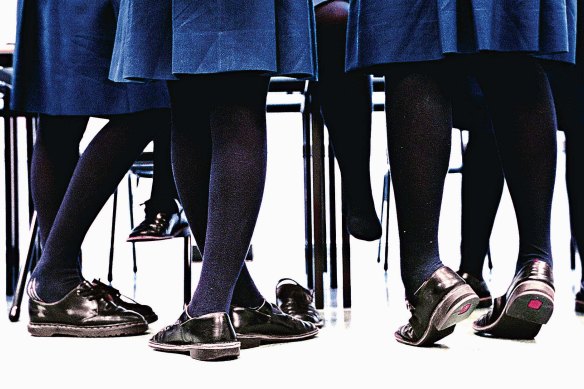This was published 2 years ago
Opinion
Girls’ schools buck decline in maths participation
Loren Bridge
ContributorGirls’ participation in maths – and indeed all STEM subjects – has long been a topic of global concern. In particular, schools, educators and parents have sought out strategies to keep girls engaged and participating in advanced maths and science in secondary school.

Girls at single-sex schools are 85 per cent more likely to take advanced mathematics than girls in co-ed schools.Credit: Erin Jonasson
Despite efforts to engage girls in STEM (science, technology, engineering, and mathematics), recent HSC data shows that girls’ involvement in higher-level maths is steadily declining — yet data from the Victorian Certificate for Education shows that girls at single-sex schools are 85 per cent more likely to take advanced mathematics than girls in co-ed schools.
They are also 79 per cent more likely to study chemistry, 68 per cent more likely to take intermediate mathematics, and 47 per cent more likely to study physics. Across the board, girls’ schools deliver higher participation in STEM subjects and this is supported by higher levels of engagement, enjoyment and aspiration.
The OECD’s Program for International Student Assessment data confirms that girls’ school students also outperform co-educated girls on PISA’s academic measures of science, mathematics and literacy. So, what’s happening in girls’ schools?
There are many foundational aspects that foster interest and enthusiasm for STEM subjects at girls’ schools, and this can begin as early as preschool. Recent research with preschool aged children has found — once again — that boys dominate the STEM-focused play areas, such as building blocks in sandpits, while girls only gain access over time by adopting “helping” roles, such as passing blocks or fetching materials. These gender biases may be established in the early years, but they are reinforced in primary and secondary school. In girls’ schools, these gender biases are simply absent.
In girls’ schools, all leadership positions fall to girls — whether they are formally recognised or the incidental roles that emerge from play, and in later years from collaborative learning.
Without the spectre of these gendered biases looming large, girls feel less self-conscious about taking the lead (or indeed tackling the “so-called” tough subjects) and they experience a greater sense of belonging in any role or subject they take on — whether it is in the science lab or on the sports field.
These experiences give girls confidence to choose subjects based on their interests, rather than the risk-avoidance strategy of “minimising effort to maximise ATAR scores”. We would argue girls’ schools give students the confidence to choose these “harder” STEM subjects, fortified by both the encouragement they receive and a culture that normalises girls’ mathematical abilities.
It is for this reason, that in both Australia and Aotearoa New Zealand, graduates of girls’ schools are significantly more likely to enter highly paid, male-dominated fields such as engineering and construction.
Studies continue to provide evidence of teachers’ implicit biases towards boys. Teachers give more attention to boys in co-educational classrooms and are more likely to direct boys towards STEM careers including mathematics, engineering, physics and computing. Research also shows that instances of marginalisation, such as sandpit engineering projects (like those described above) are often reinforced by biased actions and words of adults. Perhaps this is why girls as young as six already report feeling less confident about their maths ability than boys.
Girls’ schools push against these societal constructs, helping girls to explore all their abilities and talents, free from gender influences.
In a girls-only environment, students are equipped with the motivation, self-belief and resilience to feel confident about their abilities — and not just in maths and science but also in leadership roles, PE and sports. They are consequently more assertive, more willing to take risks, and to ask critical questions that develop their own understanding. Crucially, they are more prepared to make mistakes to take these social risks.
Girls’ schools provide an alternative narrative to the constant barrage of gender-biased messaging girls receive about what they “usually do and do not do” — from labour division in the sandpit to the depiction of gender roles in the media.
If we want higher participation rates in STEM for girls, we need more girls’ schools.